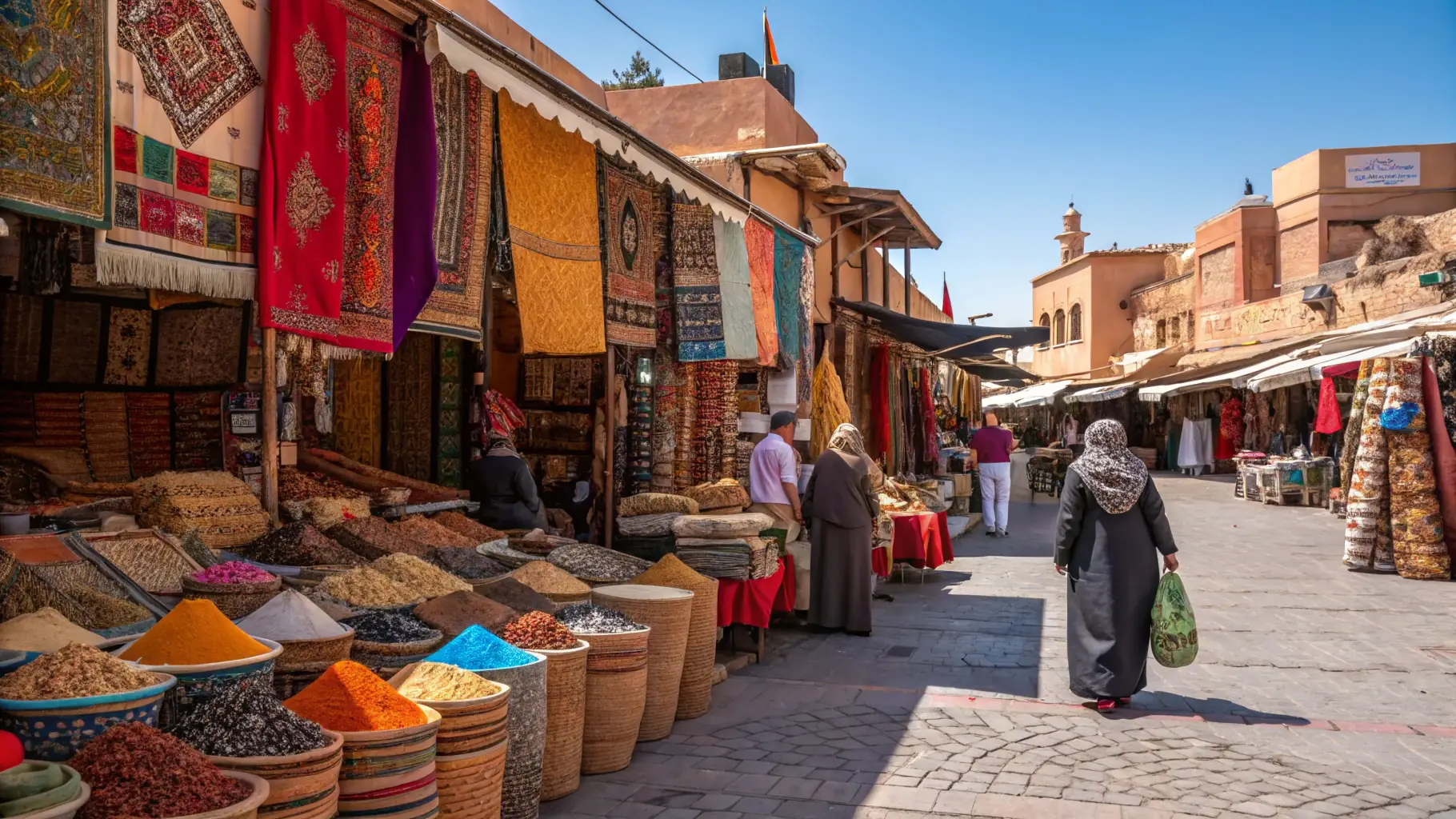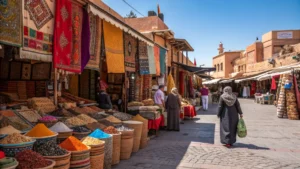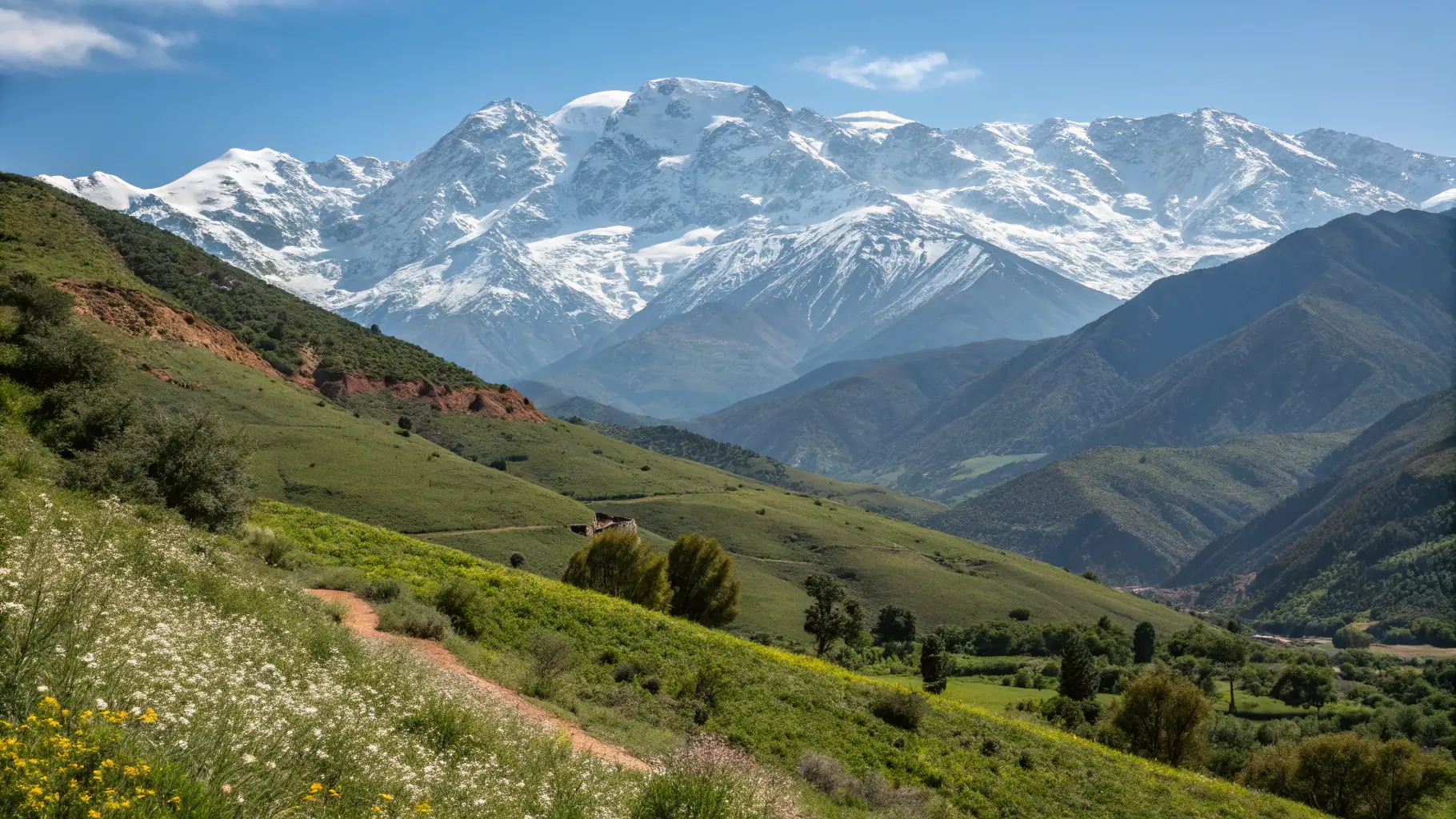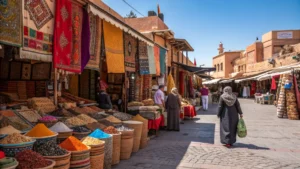Marrakech, the ancient Red City of Morocco, is a sensory feast where the aroma of exotic spices fills the air, vibrant colors captivate the eye, and centuries-old culinary traditions continue to thrive. While most visitors are drawn to the bustling Jemaa el-Fnaa square and its surrounding tourist restaurants, the true essence of Marrakech’s food scene lies hidden within the labyrinthine medina alleys, family-run establishments, and local haunts that have perfected recipes passed down through generations. This guide will take you beyond the typical tourist trail to discover authentic flavors, secret eateries, and culinary experiences that will transform your Marrakech visit into an unforgettable gastronomic adventure.
The Magic of Moroccan Cuisine
Before we dive into specific locations, let’s understand what makes Moroccan cuisine so special. Situated at the crossroads of Arab, Berber, Mediterranean, and African influences, Moroccan food represents one of the world’s most diverse and sophisticated culinary traditions.
Key Elements of Marrakech’s Food Culture:
- Spice Complexity: The masterful use of spice blends like ras el hanout (containing up to 30 different spices)
- Sweet-Savory Balance: The distinctive pairing of meats with fruits and honey
- Slow Cooking: Traditional tagines that slow-cook ingredients to perfection
- Bread Culture: Fresh khobz (bread) baked daily as an essential dining companion
- Mint Tea Ceremony: The ritualistic preparation and serving of sweet mint tea
Hidden Breakfast Treasures
Café Clock’s Traditional Breakfast
While Café Clock may appear on some tourist radars, its authentic Moroccan breakfast remains one of the city’s best-kept secrets. Tucked away in the Kasbah district, this cultural hub serves a breakfast feast featuring beghrir (Moroccan pancakes with honeycomb-like textures), msemen (flaky square-shaped pancakes), and farm-fresh eggs seasoned with cumin.
Location: 224 Derb Chtouka, Kasbah, Marrakech Why It’s Special: Their breakfast combines traditional elements with artistic flair in a setting that showcases local art and music.
La Famille’s Garden Breakfast
Hidden behind an unmarked door in the medina, La Famille’s garden setting offers a peaceful retreat from the bustling souks. Their breakfast focuses on organic, locally-sourced ingredients.
Location: 42 Riad Zitoun Jdid, Medina Why It’s Special: Their homemade yogurt with local honey and fresh seasonal fruit provides a refreshing start to your day of exploration.
Authentic Lunch Spots
Mechoui Alley
Perhaps the most iconic hidden food gem in Marrakech is the narrow passage near the Bahia Palace known informally as “Mechoui Alley.” Here, you’ll find whole lambs slow-roasted in underground clay ovens until the meat becomes melt-in-your-mouth tender.
Location: Near Bahia Palace (ask locals for directions to the mechoui vendors) Why It’s Special: The preparation method has remained unchanged for centuries, and the vendors serve only this one perfected dish.
Chez Lamine
While in Mechoui Alley, look for Chez Lamine, a legendary establishment where you can watch the theatrical carving of the lamb. The owner pulls pieces apart with his hands (protected by heat-resistant calluses developed over decades of handling hot meat).
Location: Mechoui Alley, Medina Why It’s Special: The simplicity of seasoning (mainly salt and cumin) lets the quality of the slow-roasted meat shine through.
Amal Women’s Training Center & Moroccan Restaurant
This hidden gem serves multiple purposes: offering exceptional Moroccan cuisine while empowering disadvantaged local women through culinary training. Their daily-changing menu features authentic home-style dishes rarely found in tourist establishments.
Location: Corner of Rue Allal Ben Ahmed and Rue Ibn Aicha, Gueliz Why It’s Special: Their Friday couscous is prepared the traditional way—steamed three times and hand-fluffed to achieve the perfect texture.
Afternoon Sweet Treats & Tea
Patisserie des Princes
While many tourists head to the well-known Patisserie Al Jawda, locals prefer this less conspicuous establishment for the city’s finest Moroccan pastries.
Location: 32 Rue Bab Agnaou Why It’s Special: Their gazelle horns (kaab el ghazal)—crescent-shaped cookies filled with almond paste and scented with orange blossom—offer the perfect balance of sweetness.
Atay Café Food
Hidden on a rooftop with panoramic views of the medina, this café serves unusual tea blends that incorporate local herbs and spices not commonly offered to tourists.
Location: 62 Rue Amsefah, Medina Why It’s Special: Try their saffron mint tea—a luxury variation of the traditional mint tea with subtle floral notes.
Dinner Experiences Beyond Compare
Al Fassia
This exceptional restaurant stands out not only for its food but also for being entirely operated by women—a rarity in Morocco’s restaurant scene. Located away from the tourist center, it specializes in traditional Fassi cuisine (from Fez).
Location: 55 Boulevard Zerktouni, Gueliz Why It’s Special: Their shoulder of lamb with almonds and caramelized plums represents the pinnacle of Moroccan sweet-savory mastery.
Naima’s Home Cooking
For the ultimate hidden gem experience, arrange a dinner at Naima’s home through her small cooking school. This provides an intimate glimpse into a real Marrakchi household and cuisine.
Location: Arranged through booking (details provided upon reservation) Why It’s Special: Naima sources her ingredients from specific market vendors she has worked with for decades, ensuring exceptional quality and authenticity.
Le Jardin Secret Café
Hidden within a restored 19th-century palace and garden complex, this café offers faithful renditions of Moroccan classics in a stunning historical setting far from the tourist crowds.
Location: 121 Rue Mouassine, Medina Why It’s Special: Their rabbit tagine with preserved lemons and olives is a rarely found dish that showcases the subtlety of Moroccan cooking.
Street Food Adventures
B’stilla from Souk Kessabine
Near the spice market, several unmarked stalls sell b’stilla (also spelled pastilla)—a savory-sweet pie traditionally made with pigeon, almonds, and eggs, dusted with cinnamon and sugar.
Location: Souk Kessabine, northeast of Jemaa el-Fnaa Why It’s Special: This labor-intensive dish is increasingly rare to find made the traditional way with multiple layers of tissue-thin warka pastry.
Mahlaba from Street Vendors
Found only in specific corners of the medina in the early evening, mahlaba is a warming almond and rice flour beverage topped with cinnamon and crushed nuts.
Location: Various evening carts, particularly near Bab Doukkala Why It’s Special: This traditional comfort food is becoming increasingly rare as younger generations favor modern beverages.
Unique Food Shopping Experiences
Dar Bellarj Spice Workshop
While tourists flock to the colorful spice stalls in the main souks, this cultural foundation occasionally hosts workshops where local spice masters reveal the secrets behind authentic ras el hanout blending.
Location: 9 Toualate Zaouiate Lahdar, Medina Why It’s Special: Participants create personalized spice blends under expert guidance—a souvenir with real culinary value.
Les Domaines du Val d’Argan
Just outside Marrakech, this pioneering Moroccan winery produces unique wines adapted to the local terroir, including varieties that pair specifically with Moroccan cuisine.
Location: Route de Taroudant, Ounagha (day trip from Marrakech) Why It’s Special: Their Moroccan-French fusion approach creates wines specifically designed to complement the flavors of traditional tagines.
Cooking Classes with a Difference
The Amal Center’s Social Impact Cooking Class
Rather than the typical tourist-oriented cooking class, Amal Center offers an opportunity to learn from women who have cooked these dishes their entire lives while supporting the center’s mission.
Location: Corner of Rue Allal Ben Ahmed and Rue Ibn Aicha, Gueliz Why It’s Special: The techniques taught here are the authentic methods used in Moroccan homes, not simplified versions for tourists.
Souk Cuisine’s Market-to-Table Experience
This immersive experience begins with sourcing ingredients from specific vendors in the souks, using a traditional shopping list and haggling alongside locals.
Location: Meeting point provided upon booking Why It’s Special: The class includes learning about ingredient selection and quality assessment—skills that transform how you’ll shop for food even back home.
Seasonal Specialties Worth Seeking
Tanjia During Friday Lunch
Tanjia Marrakchia is a unique local specialty—a clay pot of meat slow-cooked in the hot ashes of the hammam (public bath) fires. Traditionally prepared by men for Friday gatherings, it’s available at specific establishments.
Location: Rahba Lakdima square, at the small restaurants behind the spice shops Why It’s Special: This dish exemplifies Marrakech’s distinct culinary identity, setting it apart from other Moroccan cities.
Seasonal Fruit Smoothies at Jemaa el-Fnaa
While the square itself is hardly hidden, knowing which smoothie vendors are favored by locals can transform your experience. Look for stalls with numbers 5, 11, or 32.
Location: Jemaa el-Fnaa, central Marrakech Why It’s Special: These vendors use seasonal fruits like prickly pear, pomegranate, and special Moroccan varieties of melon not found elsewhere.
Navigating Dietary Preferences
Vegan Treasures at Earth Café
Hidden down an unmarked alley near the spice souk, Earth Café serves purely plant-based Moroccan cuisine—a rarity in this meat-loving culture.
Location: 2 Derb Zawak, Riad Zitoun Kedim Why It’s Special: Their innovative tagines showcase how traditional cooking methods can create deeply flavorful vegan dishes.
Gluten-Free Options at Le Jardin
This restaurant-garden oasis offers modified traditional recipes suitable for celiac visitors without compromising authenticity.
Location: 32 Rue El Jeld, Medina Why It’s Special: Their specially developed gluten-free bread recipe allows those with dietary restrictions to participate in Morocco’s important bread culture.
Cultural Context: Food Customs to Enhance Your Experience
Understanding local food customs can transform your culinary adventures in Marrakech:
- Communal Eating: Traditional Moroccan meals are shared from a central dish, with each person eating from the section directly in front of them.
- Right Hand Only: Follow the local custom of eating with your right hand only when having traditional meals.
- Bread Functionality: Bread serves as both food and utensil; tear small pieces to scoop up food.
- Tea Etiquette: Accept at least two glasses of tea when offered, as declining may be considered impolite.
- Ramadan Considerations: During the holy month, respect those fasting by eating discreetly during daylight hours, and experience the special evening food culture.
Best Times for Culinary Exploration
- Morning Markets (7-9am): Witness vendors setting up and securing the freshest produce
- Friday Couscous: Experience this important tradition when restaurants prepare their most elaborate versions
- Ramadan Evenings: While daytime options are limited, the iftar (breaking of fast) offers unique seasonal specialties
- Early Fall: When dates and olives are being harvested, bringing special dishes to seasonal menus
Practical Tips for Food Adventurers
- Water Safety: Stick to bottled water and avoid raw salads in very small establishments
- Haggling at Food Souks: Negotiate prices at markets but not at seated restaurants
- Language Basics: Learning a few food terms in Darija (Moroccan Arabic) opens doors to more authentic experiences
- Cash Necessity: Many hidden gem eateries don’t accept cards
- Photography Etiquette: Always ask permission before photographing food vendors or their setups
Conclusion
Marrakech’s hidden culinary treasures offer more than just delicious meals—they provide windows into Moroccan culture, history, and daily life. By venturing beyond the tourist trail and embracing these authentic food experiences, you’ll discover the soul of this magnificent city through its flavors. The Red City’s most memorable tastes aren’t found in guidebooks but in the small family-run operations, seasonal specialties, and time-honored traditions that continue to thrive in the medina’s quiet corners and neighborhood eateries.
Whether you’re savoring the melting tenderness of carefully prepared mechoui, learning ancestral techniques in an intimate cooking class, or simply enjoying a perfectly crafted mint tea on a quiet rooftop, Marrakech rewards the curious food lover with experiences that engage all the senses. Let your culinary adventure begin!
Have you discovered any hidden food gems in Marrakech? Share your experiences in the comments below!



